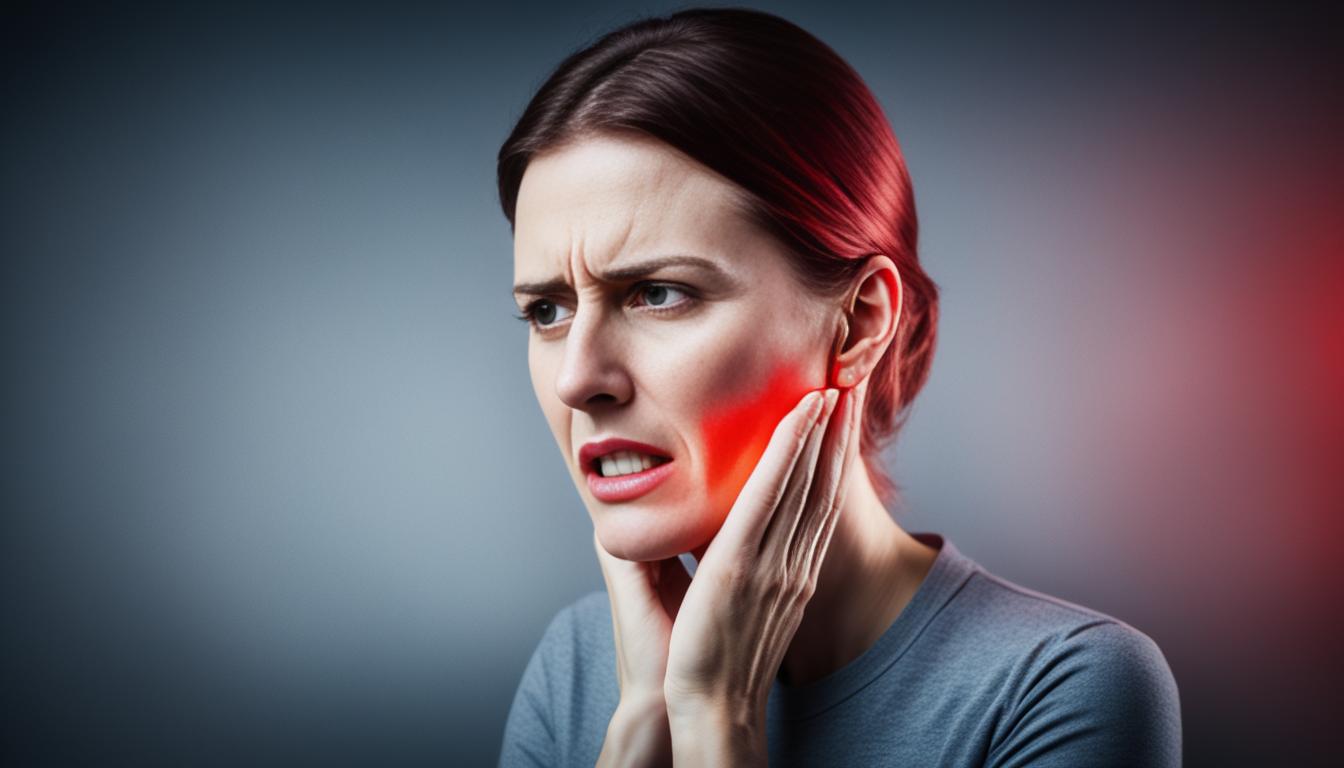Experiencing pain in the right side of your face, jaw, and ear can be distressing. This article will explore the possible causes of this pain and provide effective treatments for relief.
Causes of Pain in Right Side of Face and Jaw and Ear
Pain in the right side of the face, jaw, and ear can be caused by various factors. Understanding these causes is crucial in determining the appropriate treatment. Here are the common causes of such pain:
1. TMJ Disorders
Temporomandibular joint (TMJ) disorders can lead to pain in the right side of the face, jaw, and ear. These disorders affect the joints and muscles in the jaw, causing discomfort and restricted movement.
2. Osteoarthritis, Rheumatoid Arthritis, and Psoriatic Arthritis
Arthritis, such as osteoarthritis, rheumatoid arthritis, and psoriatic arthritis, can also contribute to pain in the right side of the face, jaw, and ear. These conditions cause inflammation and damage to the joints, resulting in discomfort and stiffness.
3. Migraine
Migraines are severe headaches that can cause pain in various areas of the face, including the right side. The pain is often accompanied by other symptoms such as nausea, sensitivity to light and sound, and visual disturbances.
4. Swimmer’s Ear
Swimmer’s ear, or otitis externa, is an infection of the ear canal that can cause pain in the right side of the face and ear. It is often caused by water getting trapped in the ear, creating a moist environment ideal for bacterial growth.
5. Sinusitis
Sinusitis, an inflammation of the sinuses, can lead to pain in the right side of the face and ear. This condition occurs when the sinuses become blocked and filled with fluid, causing pressure and discomfort.
6. Dental Issues
Various dental issues can contribute to pain in the right side of the face, jaw, and ear. Cavities, periodontal disease, or infections in the teeth or gums can cause localized pain and discomfort.
7. Teeth Grinding
Teeth grinding, also known as bruxism, can cause pain in the jaw and ear. This habit typically occurs during sleep and can lead to tooth damage, jaw pain, and discomfort in the surrounding areas.
| Causes | Explanation |
|---|---|
| TMJ Disorders | Disorders affecting the jaw joints and muscles. |
| Osteoarthritis, Rheumatoid Arthritis, and Psoriatic Arthritis | Inflammation and damage to the joints in the face and jaw. |
| Migraine | Severe headaches that can affect the face, including the right side. |
| Swimmer’s Ear | Infection of the ear canal that causes pain in the face and ear. |
| Sinusitis | Inflammation and blockage of the sinuses, resulting in facial pain. |
| Dental Issues | Cavities, gum disease, or tooth infections leading to localized pain. |
| Teeth Grinding | Involuntary grinding or clenching of the teeth, often during sleep. |
Symptoms Associated with Pain in the Right Side of the Face, Jaw, and Ear
Pain in the right side of the face, jaw, and ear can be accompanied by a variety of symptoms. These symptoms serve as valuable indicators in determining the underlying cause of the pain. Some of the common symptoms associated with pain in the right side of the face, jaw, and ear include:
- Facial pain
- Pain from chewing
- Jaw clicking or locking
- Ear ringing
- Hearing loss
- Neck and shoulder pain
- Teeth shifting and misalignment
- Headaches
- Swelling in the jaw
- Throbbing pain
- Nausea
- Changes in vision or other senses
- Drainage
- Pain along the face and neck
- Hearing reduction
- Itching
- Fever
- Clogged nasal passages
- Green or yellow discharge
- Sensitivity of the face
- Cough
- Reduced ability to smell and taste
- Pain throughout the lower face and neck
- Swelling in the gums and face
- Loose or sensitive teeth
- Sensitivity to hot and cold foods and beverages
- Fever and flu-like symptoms
These symptoms can vary depending on the cause of the pain. It is important to consult a healthcare professional for an accurate diagnosis and appropriate treatment based on the specific symptoms experienced.
Understanding TMJ Disorder Symptoms
When pain in the right side of the face, jaw, and ear is related to temporomandibular joint (TMJ) disorder, symptoms may include:
- Jaw clicking or popping
- Jaw stiffness
- Difficulty opening or closing the mouth
- Lockjaw
- Ear pain or a feeling of fullness in the ears
Identifying Arthritis Symptoms
In cases where arthritis is the cause of pain, symptoms may include:
- Joint pain
- Swelling and inflammation
- Stiffness
- Decreased range of motion
Recognizing Migraine Symptoms
Migraines can also cause pain in the right side of the face, jaw, and ear, accompanied by symptoms such as:
- Throbbing or pulsating pain
- Sensitivity to light and sound
- Nausea and vomiting
- Visual disturbances
It is important to note that migraines can present with symptoms beyond the head and face.
Understanding Swimmer’s Ear Symptoms
Swimmer’s ear, a condition typically caused by water entering the ear canal, can cause pain in the ear, face, and jaw. Symptoms may include:
- Ear pain or discomfort
- Itching in the ear canal
- Fluid drainage
- Pain worsened by moving the ear or jaw
Recognizing Sinusitis Symptoms
Sinusitis, which is the inflammation of the sinuses, can lead to pain in the face, jaw, and ear. Symptoms may include:
- Facial pain or pressure
- Congestion
- Nasal discharge
- Cough
- Fever
Identifying Dental Issues Symptoms
Pain in the right side of the face, jaw, and ear can also be caused by dental issues. Symptoms may include:
- Toothache
- Gum swelling and tenderness
- Loose or sensitive teeth
- Changes in tooth alignment
- Pain worsened by biting or chewing
Recognizing Teeth Grinding Symptoms
Teeth grinding, also known as bruxism, can cause pain in the face, jaw, and ear. Symptoms may include:
- Jaw pain or soreness
- Headaches
- Tooth sensitivity
- Worn-down teeth
These are just a few examples of the symptoms that may accompany pain in the right side of the face, jaw, and ear. It is crucial to consult a healthcare professional for a thorough evaluation and appropriate diagnosis based on individual symptoms.
Diagnosis of Pain in the Right Side of the Face, Jaw, and Ear
To determine the cause of pain in the right side of the face, jaw, and ear, a doctor will typically conduct a thorough physical examination and review the individual’s health history. These initial steps are crucial for guiding further diagnostic tests and investigations.
During the physical exam, the doctor will carefully evaluate the affected areas, looking for any visible signs of inflammation, injury, or abnormalities. They may palpate the jaw joint, assess the range of motion in the jaw, and examine the ears and facial structures for any abnormalities or tenderness.
Obtaining a detailed health history is equally important. The doctor may inquire about the onset, duration, and intensity of the pain, as well as any specific triggers or factors that worsen or alleviate the symptoms. It is essential to provide relevant information about any previous injuries, surgeries, or dental procedures that could potentially contribute to the pain.
Depending on the suspected underlying condition, additional diagnostic tests may be necessary. Among these are:
- MRI (Magnetic Resonance Imaging): This imaging test uses powerful magnets and radio waves to create detailed images of the jaw joint, surrounding structures, and soft tissues. It can help identify any abnormalities or damage to the joint, such as osteoarthritis or disc displacement.
- X-ray: X-rays may be taken to assess the bones and joints in the affected area. They can detect fractures, bone spurs, or other structural abnormalities that could be causing the pain.
- Imaging tests: Other imaging tests, such as computed tomography (CT) scans or cone-beam imaging, may also be performed to provide a more comprehensive assessment of the affected area.
These diagnostic tests help the doctor gain a clearer understanding of the underlying cause of the pain in the right side of the face, jaw, and ear.
Example
| Diagnostic Test | Description |
|---|---|
| MRI (Magnetic Resonance Imaging) | An imaging test that uses magnets and radio waves to create detailed images of the affected area. Helps identify joint abnormalities, soft tissue damage, or other structural issues. |
| X-ray | A type of imaging test that uses low levels of radiation to capture images of the bones and joints in the face, jaw, and ear. Detects fractures, bone spurs, or other skeletal abnormalities. |
| Imaging tests | Other imaging tests, such as CT scans or cone-beam imaging, may be used to provide a more comprehensive evaluation of the affected area. |

Treatments for Pain in the Right Side of the Face, Jaw, and Ear
The treatment options for pain in the right side of the face, jaw, and ear depend on the underlying cause. It is important to determine the specific condition causing the pain in order to provide appropriate relief. Here are some common treatments for various causes of pain in the right side of the face, jaw, and ear:
TMJ Disorder Treatments
For TMJ disorders, treatment options include:
- Resting the jaw and avoiding excess chewing
- Implementing home remedies such as warm compresses and relaxation techniques
- Using over-the-counter anti-inflammatory medications to alleviate pain and swelling
- Wearing braces or splints to help reposition the jaw
- Undergoing joint flushing for severe cases
- Surgical intervention in rare cases
Osteoarthritis and Arthritis Treatments
Treatments for osteoarthritis and other forms of arthritis may include:
- Prescription medications to reduce inflammation and manage pain
- Physical therapy to improve joint mobility and strengthen surrounding muscles
- Lifestyle modifications such as weight management and exercise
Migraine Treatments
To manage migraines, healthcare professionals may recommend:
- Prescription medications specifically designed for migraine relief
- Lifestyle changes to identify and avoid triggers
- Stress reduction techniques and relaxation exercises
Swimmer’s Ear and Sinusitis Treatments
Treatments for swimmer’s ear and sinusitis may involve:
- Antibiotics to clear up bacterial infections
- Over-the-counter decongestants and nasal sprays to relieve nasal congestion
- Prescription medications for severe cases
- Home remedies such as warm saline rinses and steam inhalation
Dental Issue Treatments
If dental issues are the cause of pain, treatments may include:
- Tooth removal or extraction to alleviate pain and prevent further damage
- Root canal therapy to save an infected tooth
- Deep cleaning to treat gum disease
Teeth Grinding Treatments
For teeth grinding, treatment options include:
- Wearing a mouth guard or splint to protect the teeth and alleviate grinding
- Lifestyle changes such as avoiding caffeine and alcohol, and managing stress
- Relaxation techniques to reduce muscle tension
In addition to these treatments, there are also various home remedies and self-care practices that can provide relief. These may include diet changes, warm or cold compresses, and gentle exercises to improve jaw mobility. It is important to consult with a healthcare professional or specialist to determine the most suitable treatment plan for your specific condition.
Medications may also be prescribed to manage pain and inflammation associated with conditions causing pain in the right side of the face, jaw, and ear. They may include nonsteroidal anti-inflammatory drugs (NSAIDs), muscle relaxants, or nerve blockers. It is crucial to follow the prescribed dosage and instructions provided by the healthcare professional.
Trigeminal Neuralgia as a Possible Cause of Pain in the Right Side of the Face, Jaw, and Ear
Trigeminal neuralgia is a condition that can cause severe pain in the face, jaw, and ear. It is characterized by pain coming from the trigeminal nerve, which starts near the top of the ear and branches out towards the eye, cheek, and jaw.
The exact cause of trigeminal neuralgia is unknown, but it may be associated with blood vessel compression, facial trauma, or certain medical conditions. The pain experienced by individuals with trigeminal neuralgia is often described as stabbing, lancinating, or electric.
Individuals with trigeminal neuralgia may experience sudden episodes of intense facial pain triggered by normal activities such as eating, drinking, talking, or touching the face. These episodes can be debilitating and significantly impact a person’s quality of life.

Diagnosing trigeminal neuralgia involves a thorough evaluation by a healthcare professional, including a comprehensive medical history and physical examination. In some cases, additional imaging tests such as MRIs may be required to confirm the diagnosis.
Treatment options for trigeminal neuralgia aim to relieve the debilitating pain and improve the individual’s quality of life. Medications, such as anticonvulsants and muscle relaxants, can help manage pain and reduce the frequency of episodes. For individuals who do not respond to medication or experience severe symptoms, surgical interventions may be necessary to alleviate the compression or irritation of the trigeminal nerve.
Treatment for Trigeminal Neuralgia
Treatment for trigeminal neuralgia may include:
- Anticonvulsant medications, such as carbamazepine, to reduce pain and prevent episodes
- Muscle relaxants to alleviate muscle tension and reduce pain
- Trigeminal nerve blocks or injections to provide temporary relief
- Microvascular decompression surgery to relieve pressure on the trigeminal nerve
- Radiofrequency ablation to selectively destroy nerve fibers causing pain
- Glycerol injections to damage the trigeminal nerve and provide pain relief
- Gamma Knife radiosurgery to target and destroy specific nerve pathways
It is essential for individuals experiencing pain in the right side of the face, jaw, and ear to consult with a healthcare professional for an accurate diagnosis and appropriate treatment plan. Trigeminal neuralgia is a complex condition that requires specialized care to manage symptoms effectively.
| Causes of Trigeminal Neuralgia | Symptoms of Trigeminal Neuralgia |
|---|---|
| Blood vessel compression | Episodic and sudden intense facial pain |
| Facial trauma | Stabbing, lancinating, or electric pain |
| Medical conditions | Triggered by normal activities (eating, drinking, talking, touching the face) |
Home Remedies and Medical Treatments for Pain in the Right Side of the Face, Jaw, and Ear
To manage pain in the right side of the face, jaw, and ear, there are various home remedies and medical treatments available. These can provide relief and improve overall comfort and well-being. Let’s explore some effective options:
Home Remedies
1. Diet changes: A healthy diet consisting of anti-inflammatory foods, such as fruits and vegetables, whole grains, and omega-3 fatty acids, can help reduce facial and jaw pain and promote healing.
2. Relaxation techniques: Practicing relaxation techniques, such as deep breathing exercises, meditation, and yoga, can help alleviate muscle tension and promote relaxation in the face and jaw.
3. Warm/cold compresses: Applying a warm or cold compress to the affected area can help reduce swelling, inflammation, and pain. Experiment with both options to see which provides the most relief.
4. TMJ exercises: Performing prescribed exercises specifically designed for TMJ disorders can help strengthen the jaw muscles, improve flexibility, and reduce pain. Consult a healthcare professional for guidance on appropriate exercises.
Medical Treatments
1. TMJ home remedies: For TMJ disorders, conservative treatments such as over-the-counter anti-inflammatory medications, muscle relaxants, and night guards or splints to prevent teeth grinding may be recommended.
2. TMJ medical treatments: In severe cases of TMJ disorders that do not respond to home remedies, medical interventions such as corticosteroid injections, joint flushing, or arthrocentesis may be considered. In rare cases, surgery might be necessary to correct structural abnormalities or joint damage.
3. Trigeminal neuralgia home remedies: For trigeminal neuralgia, home remedies may focus on managing pain with relaxation techniques, warm compresses, and avoiding triggers such as cold or hot foods.
4. Trigeminal neuralgia medical treatments: Medications such as anticonvulsants, muscle relaxants, and nerve blocks can help reduce the intensity of trigeminal neuralgia pain. In some cases, surgical procedures like microvascular decompression or radiofrequency thermal lesioning may be recommended to alleviate nerve compression.
It’s important to consult a healthcare professional for an accurate diagnosis and appropriate treatment recommendations based on the underlying cause of the pain. They can provide personalized guidance and recommendations tailored to your specific needs.

| Home Remedies | Medical Treatments |
|---|---|
| 1. Diet changes | 1. TMJ home remedies |
| 2. Relaxation techniques | 2. TMJ medical treatments |
| 3. Warm/cold compresses | 3. Trigeminal neuralgia home remedies |
| 4. TMJ exercises | 4. Trigeminal neuralgia medical treatments |
Conclusion
Pain in the right side of the face, jaw, and ear can be distressing and disruptive to daily life. It is important to seek medical evaluation to determine the underlying cause and receive appropriate diagnosis and treatment. With the help of home remedies and medical interventions, relief and improved quality of life are possible.
Addressing the root cause of the pain is crucial in finding lasting relief. Whether it is a TMJ disorder, arthritis, sinusitis, dental issues, or trigeminal neuralgia, a personalized treatment plan can be created to alleviate discomfort and manage symptoms effectively.
By following the recommended treatment plan and incorporating lifestyle changes, individuals can experience a reduction in pain and restore their overall well-being. It is essential to prioritize self-care and listen to the body’s signals in order to achieve optimal health and minimize the impact of pain in the right side of the face, jaw, and ear.




